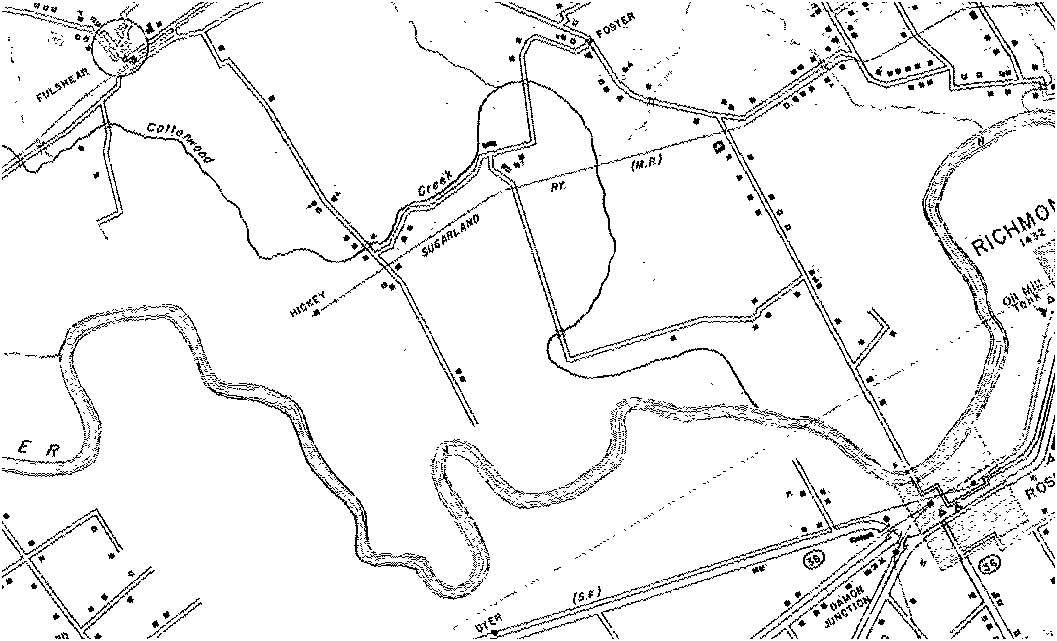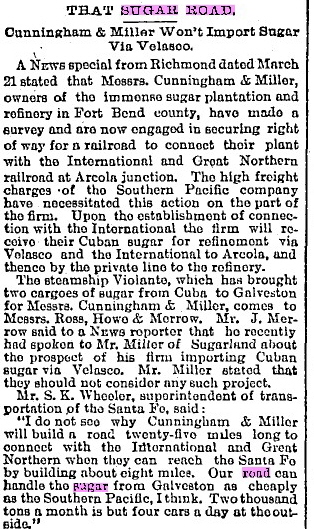
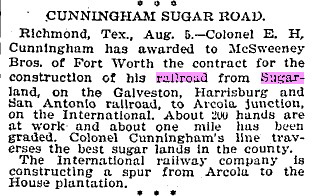
Sugar Land Railroad
The Sugar Land Railroad was funded in 1893 and construction started towards the community of Duke, Texas. After changing ownership it was completed to Otey, Texas and Anchor, Texas. The following is an attempt to trace it's original route through the modern days of 2008. Another railroad was VELASCO TERMINAL RAILWAY
[Another part of the Sugar Land Railroad ran west from Sugar Land to Cabell and ended at Hickey.]
GALVESTON DAILY NEWS MARCH 23,1893 GALVESTON DAILY NEWS AUGUST 6, 1893


GALVESTON DAILY NEWS AUGUST 8, 1893

GALVESTON DAILY NEWS AUGUST 26, 1893
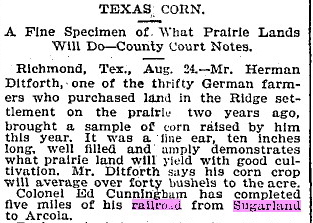
DAILY NEWS SEPTEMBER 10, 1893

GALVESTON DAILY NEWS SEPTEMBER 18, 1893
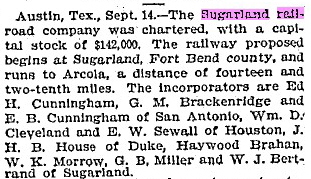
GALVESTON DAILY NEW S MAY 10, 1896
S MAY 10, 1896
The Sugar Land Railway Company was chartered on April 14, 1893, in the interest of Ed. H. Cunningham and Company, to build from Sugar Land to Arcola, both in Fort Bend County, and to connect with the International and Great Northern Railroad Company. The capital stock was $142,000, and the principal place of business was Sugar Land. The members of the first board of directors were Cunningham and George W. Brackenridge, both of San Antonio; G. B. Miller, Haywood Braban, W. K. Wornow, and W. J. Bertrand, all of Sugar Land; William D. Cleveland and E. W. Sewall, both of Houston; and J. H. B. House of Duke, Texas. During the period 1893–94 fourteen miles of track was constructed by Ed. H. Cunningham and Company. In 1895 the Sugar Land Railway reported passenger earnings of $200 and freight earnings of $17,000 and owned one locomotive and one car. Control of the railroad passed to William T. Eldridge in 1908, and the following year the Sugar Land Railway acquired one mile of yard tracks at Sugar Land from the Galveston, Harrisburg and San Antonio Railway Company. In 1912 the railroad purchased seventeen miles of private track, from mile post 10.74 to Rotchford, from the Cunningham Sugar Company. This gave the Sugar Land Railway Company a new connection with the International and Great Northern, and the four miles between mile post 10.74 and Arcola were abandoned. Also in 1912 the company acquired the Imperial Valley Railway Company running five miles from Sugar Land to Cabell along with five miles of other tracks. The railroad completed another six miles between Otey and Anchor in 1916, and twelve miles between Cabell and Hickey were added in 1931. The following year the twenty-one miles between Anchor and House Junction was abandoned. The track between Cabell and Hickey was abandoned in 1942. In 1952 the Sugar Land Railway Company reported total earnings of $545,000 and owned seven cars and no locomotives. The rest of the rolling stock was rented. In 1952 the Sugar Land Railway abandoned three miles between Cabell and Pryor. On January 2, 1926, the Sugar Land was acquired by the New Orleans, Texas and Mexico Railway Company but continued to operate as a separate company until March 1, 1956, when it was consolidated with the Missouri Pacific Railroad Company. The remaining tracks were removed in the 1970s.
|
1893 |
SL |
The
Sugar Land Railroad is chartered to build a link between Sugar Land and the
I&GN in Arcola, Texas. |
|
1894 |
SL |
Arcola
is reached by 14 miles of track; operation begins. |
|
1907 |
SL |
The
Sugar Land plantation is purchased from bankrupt Colonel E. H. Cunningham
interests by I. H. Kempner and W. T. Eldridge. Included in this purchase is
the Sugar Land Railroad. |
|
1909 |
SL |
The
Sugar Land Railway purchases the rail yard in Sugar Land, next to the
Imperial Sugar factory, from the GH&SA. |
|
1912 |
SL |
Purchases
17 miles of private track, from mile post 10.74 to Rotchford, from the
Cunningham Sugar Company. This yields a shorter connection to the I&GN,
and the final 4 miles of track to Arcola is abandoned. |
|
1912 |
SL |
Acquires
the Imperial Valley Railway Company running five miles from Sugar Land to
Cabell (now the site of a State prison along Hwy 99), along with five miles
of other tracks |
|
1916 |
SL |
6
miles of track laid between Otey and Anchor |
|
1926 |
SL
/ NOTM |
The
Sugar Land Railway was acquired by the New Orleans, Texas and Mexico Railway
Company (NOTM) but continued to operate as a separate company. |
|
1931 |
SL |
12
miles of track laid between Cabell and Hickey |
|
1932 |
SL |
21
miles of track between Anchor and House Junction was abandoned |
|
1952 |
SL |
3
miles of track between Cabell and Pryor is abandoned |
|
1952 |
SL |
Sugar
Land Railway Company reported total earnings of $545,000 and owned seven cars
and no locomotives. |
|
1956 |
SL
/ I&GN / NOTM / MP |
The
SL, I&GN and NOTM are consolidated with the re-organized Missouri Pacific
Railroad Company and lose all unique identity. |
|
1970s |
SL
/ MP |
All
remaining tracks are removed to make room for Williams Trace Road and other
components of the expansion of Sugar Land as a residential community. This
includes 31 miles of the ex-HT&B/I&GN East Columbia branch, which now
terminates at Arcola |
Cabell, Texas
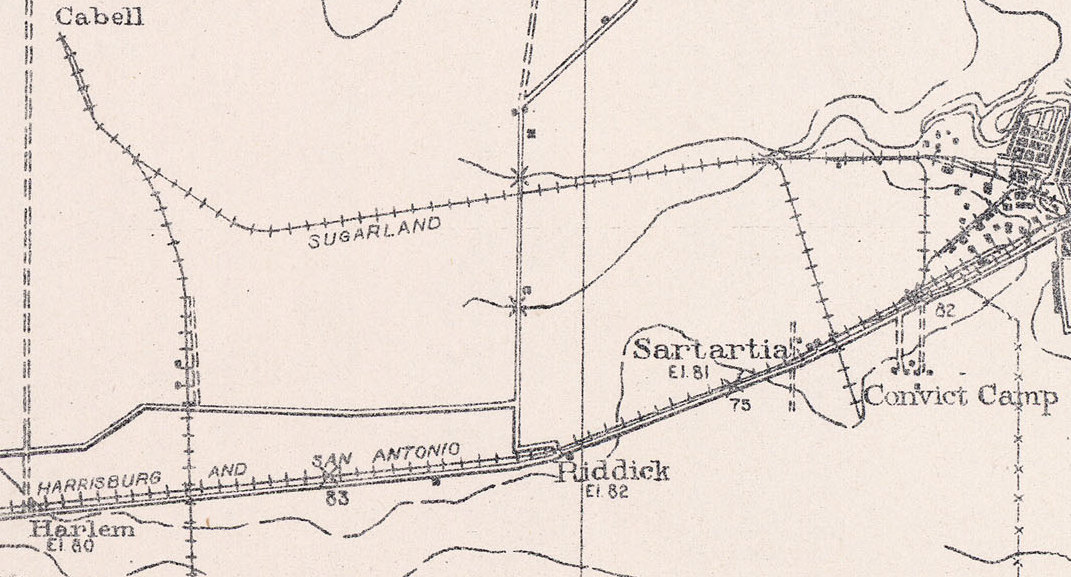
HICKEY, TEXAS (Fort Bend County). Hickey was a farming community on a mail route from Rosenberg located off Farm Road 723 in central Fort Bend County. It was probably named for M. J. Hickey, a Brazoria lawyer who settled in the area in 1885 and who became a county judge at the close of the Jaybird-Woodpecker War in 1889. Little is known about the settlement. Hickey was shown on the 1936 county highway map.
